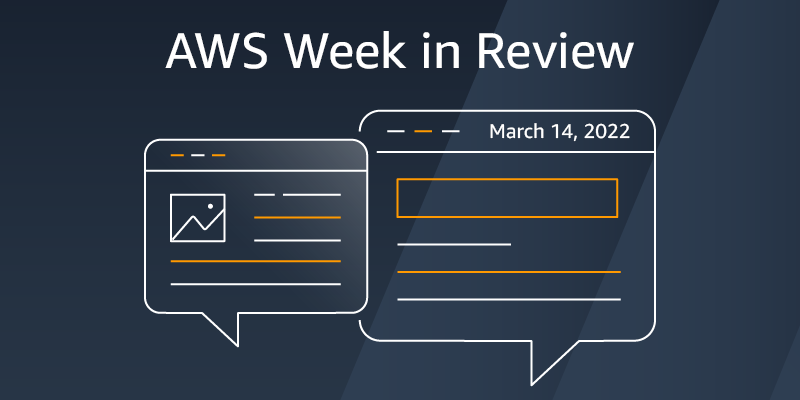15 Mar

[ad_1]
Welcome to the March 14 AWS Week in Review post, and Happy Pi Day! I hope you managed to catch some of our livestreamed Pi day celebration of the 16th birthday of Amazon Simple Storage Service (Amazon S3). I certainly had a lot of fun in the event, along with my co-hosts – check out the end of this post for some interesting facts and fun from the day.
First, let’s dive right into the news items and launches from the last week that caught my attention.
Last Week’s Launches
New X2idn and X2iedn EC2 Instance Types – Customers with memory-intensive workloads and a requirement for high networking bandwidth may be interested in the newly announced X2idn and X2iedn instance types, which are built on the AWS Nitro system. Featuring third-generation Intel Xeon Scalable (Ice Lake) processors, these instance types can yield up to 50 percent higher compute price performance and up to 45 percent higher SAP Application Performance Standard (SAPS) performance than comparable X1 instances. If you’re curious about the suffixes on those instance type names, they specify processor and other information. In this case, the i suffix indicates that the instances are using an Intel processor, e means it’s a memory-optimized instance family, d indicates local NVMe-based SSDs physically connected to the host server, and n means the instance types support higher network bandwidth up to 100 Gbps. You can find out more about the new instance types in this news blog post.
Amazon DynamoDB released two updates – First, an increase in the default service quotas raises the number of tables allowed by default from 256 to 2500 tables. This will help customers working with large numbers of tables. At the same time the service also increased the allowed number of concurrent table management operations, from 50 to 500. Table management operations are those that create, update, or delete tables. The second update relates to PartiQL a SQL-compatible query language you can use to query, insert, update, or delete DynamoDB table data. You can now specify a limit on the number of items processed. You’ll find this useful when you know you only need to process a certain number of items, helping reduce the cost and duration of requests.
If you’re coding against Amazon ECS‘s API, you may want to take a look at the change to UpdateService that now enables you to update load balancers, service registries, tag propagation, and ECS managed tags for a service. Previously, you would have had to delete and recreate the service to make changes to these resources for a service. Now you can do it all with one call, making it a hassle-free and less disruptive, more efficient experience. Take a look at the What’s New post for more details.
For a full list of AWS announcements, be sure to keep an eye on the What’s New at AWS page.
Other AWS News
If you’re analyzing time series data, take a look at this new book on building forecasting models and detecting anomalies in your data. It’s authored by Michael Hoarau, an AI/ML Specialist Solutions Architect at AWS.
March 8 was International Women’s Day and we published a post featuring several women, including fellow news blogger and published author Antje Barth, chatting about their experiences working in Developer Relations at AWS.
Upcoming AWS Events
Check your calendars and sign up for these AWS events:
.NET Application Modernization Webinar (March 23) – Sign up today to learn about .NET modernization, what it is, and why you might want to modernize. The webinar will include a deep dive focusing on the AWS Microservice Extractor for .NET.
AWS Summit Brussels is fast approaching on March 31st. Register here.
Pi Day Fun & Facts
As this post is published, we’re coming to the end of our livestreamed Pi Day event celebrating the 16th birthday of S3 – how time flies! Here are some interesting facts & fun snippets from the event:
- In the keynote, we learned S3 currently stores over 200 trillion objects, and serves over 100 million requests per second!
- S3‘s Intelligent Tiering has saved customers over $250 million to date.
- Did you know that S3, having reached 16 years of age, is now eligible for a Washington State drivers license? Or that it can now buy a lottery ticket, get a passport, or – check this – it can pilot a hang glider!
- We asked each of our guests on the livestream, and the team of AWS news bloggers, to nominate their favorite pie. The winner? It’s a tie between apple and pecan pie!
That’s all for this week. Check back next Monday for another Week in Review!
[ad_2]
Source link


